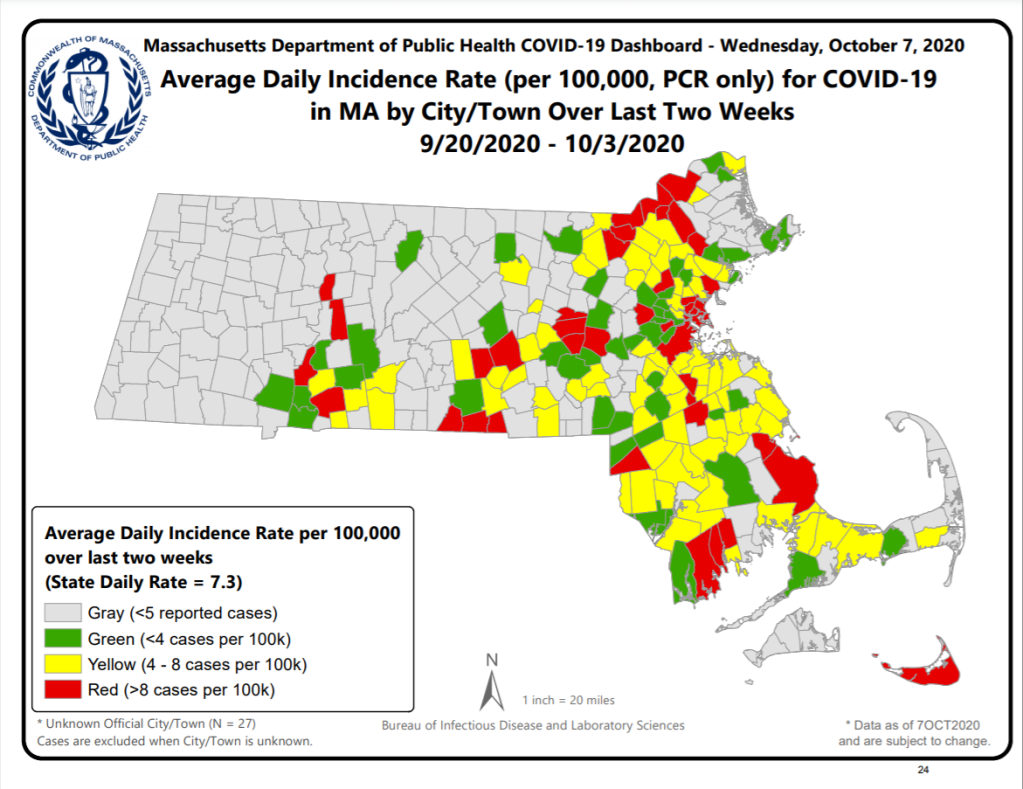Massachusetts' latest weekly data on the coronavirus pandemic, including the updated community-level risk assessment map, shows 40 communities considered at the highest risk for transmitting COVID-19, 17 more than last week.
The data, from the Department of Public Health, includes a breakdown of the total number of coronavirus cases in each Massachusetts city and town, as well as the new map and more data.
See the Town-by-Town Mass. Coronavirus Risk Map
The high-risk communities in Wednesday's report are Acushnet, Amherst, Attleboro, Avon, Boston, Brockton, Chelmsford, Chelsea, Dartmouth, Dracut, Dudley, Everett, Framingham, Haverhill, Holyoke, Hudson, Kingston, Lawrence, Leicester, Lowell, Lynn, Malden, Marlborough, Methuen, Middleton, Nantucket, New Bedford, North Andover, Plymouth, Randolph, Revere, Southborough, Southbridge, Springfield, Sunderland, Waltham, Webster, Winthrop, Woburn and Worcester.
Download our free mobile app for
iOS or Android to get the latest breaking news and in-depth coverage of COVID-19.
The map shows the number of cases detected on average each day over the last two weeks in each of Massachusetts' communities. More than 8 cases per 100,000 translates to a high risk and red shading, between 4 and 8 cases per 100,000 is moderate risk and any less than that is low risk.

This map shows the average daily number of coronavirus cases per capita in Massachusetts from Sept. 20-Oct. 3, 2020.
There are 40 cities and towns shaded red in this map, a 74% increase compared to last week's map, which included data from Sept. 13-26. There were 23 communities on last week's list from the Massachusetts Department of Public Health.
These 19 communities are new to the list since last week: Acushnet, Amherst, Brockton, Chelmsford, Dartmouth, Dudley, Holyoke, Hudson, Kingston, Leicester, Malden, Plymouth, Randolph, Southborough, Southbridge, Sunderland, Waltham, Webster, and Woburn
These two communities, Holliston and Lynnfield, were removed from the list since last week.
Read this week's full report here, with data on communities' percent positivity, county- and state-level data and more.
Boston entered the red zone last week and its average incidence rate rose to 10 coronavirus cases per 100,000 in the new Department of Public Health report.
Mayor Marty Walsh on Wednesday announced that Boston Public Schools would pause their reopening after the city’s coronavirus positivity rate climbed above the 4% cutoff it had previously outlined.
Last week, the city held off entering Step 2 of Phase 3 of Massachusetts' reopening plan because it anticipated entering the red zone.
Boston Mayor Marty Walsh said he's holding out hope that students can return to class on schedule this fall, even though the city is nearing Massachusetts' highest risk zone for coronavirus.
How Massachusetts Measures Hot Spots
Massachusetts has changed how it's measured coronavirus metrics over time.
The color-coded town-by-town data was introduced in August, and the Baker administration announced that the state would focus its strongest COVID-mitigation efforts on towns in the red category. Communities can only move to Step 2 of Phase 3 of Massachusetts' reopening plan, announced Tuesday, if they are not consistently in the red.
Previously, the positive COVID test rate over the prior 14 days had been the standard for measuring hot spots. The Department of Public Health's weekly report still includes that information, along with other metrics like how many tests are being conducted locally and how many cases have been reported locally.
However, some of Massachusetts' smaller towns have taken issue with being categorized based on cases per capita.
New Mass. communities designated by the state's as high risk for coronavirus are reacting to the designation.
They say that, when a town only has a few thousand people, an outbreak in just one household can send it into red, which is determined by 8 cases of COVID-19 per 100,000 residents.
Asked last week why he prefers using cases per capita instead of percent positivity, Gov. Charlie Baker said Tuesday that the latter doesn't take into account that some people get tested repeatedly.
"We have a lot of repeat testers in our data, many of whom are repeating for work-related reasons," Baker said.
The Link LonkOctober 08, 2020 at 09:38AM
https://www.nbcboston.com/news/coronavirus/coronavirus-risk-map-number-of-mass-communities-in-the-red-rises-to-40/2208394/
Coronavirus Risk Map: Number of Mass. Communities in the Red Rises to 40 - NBC10 Boston
https://news.google.com/search?q=Red&hl=en-US&gl=US&ceid=US:en

No comments:
Post a Comment